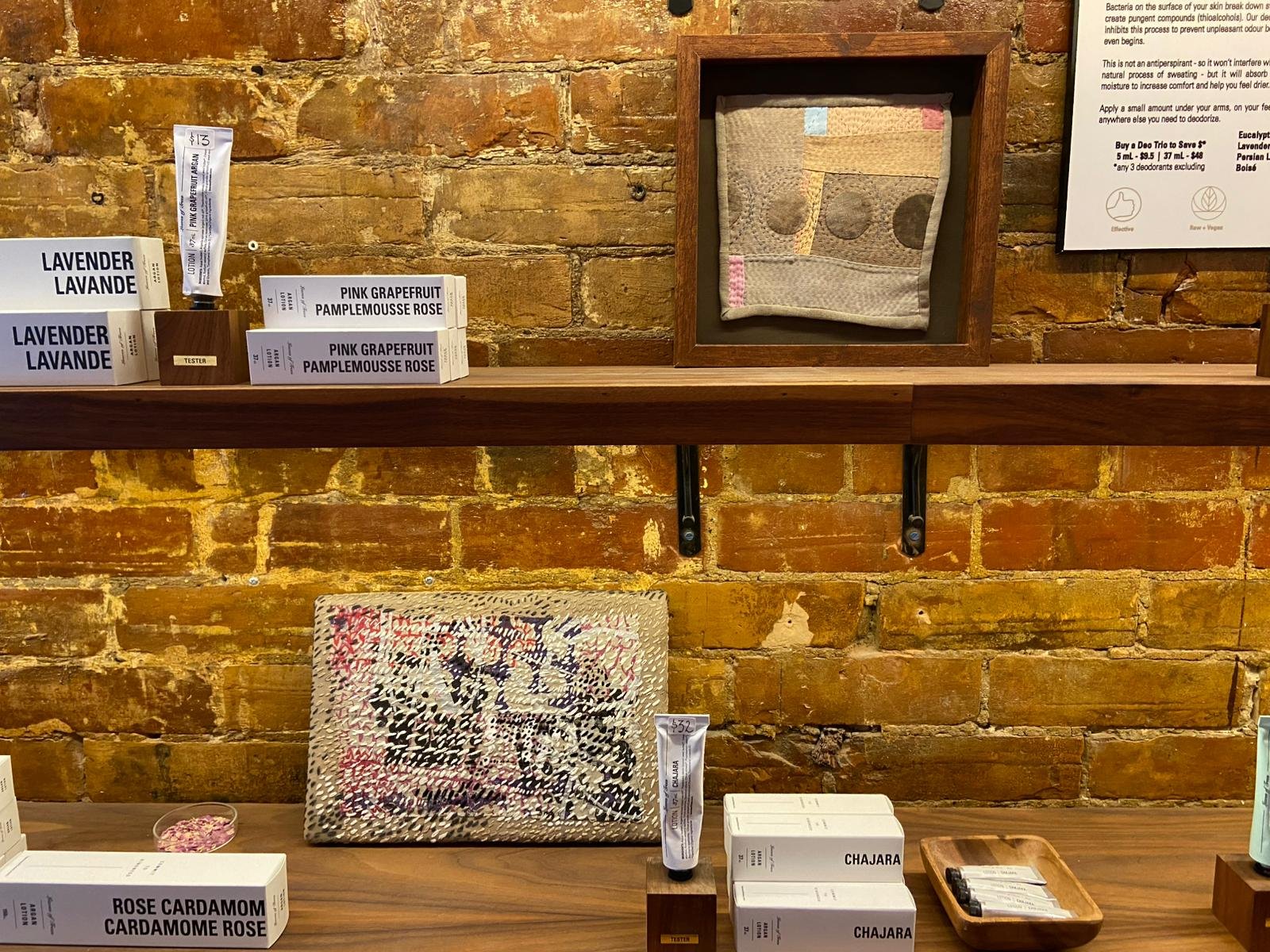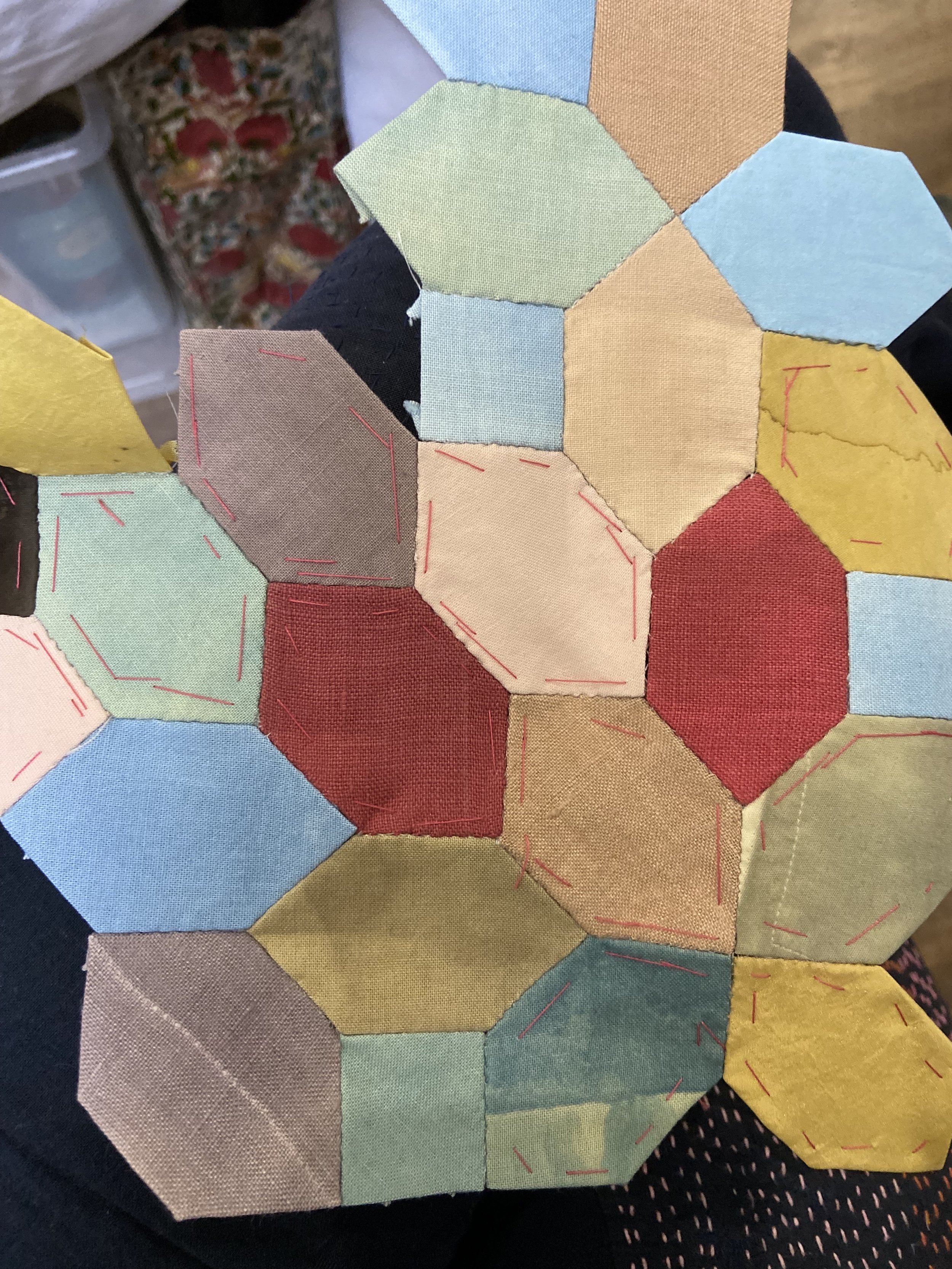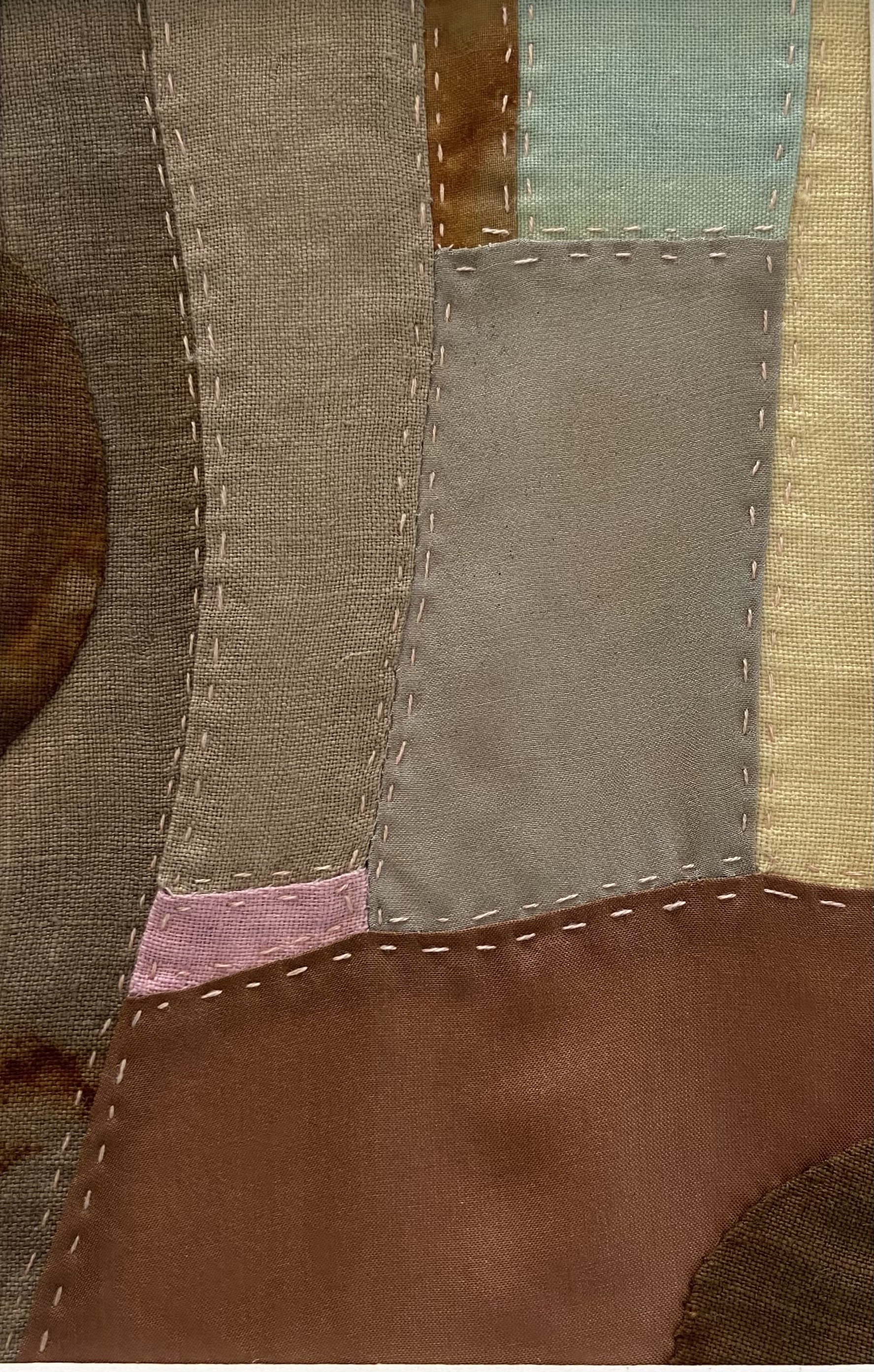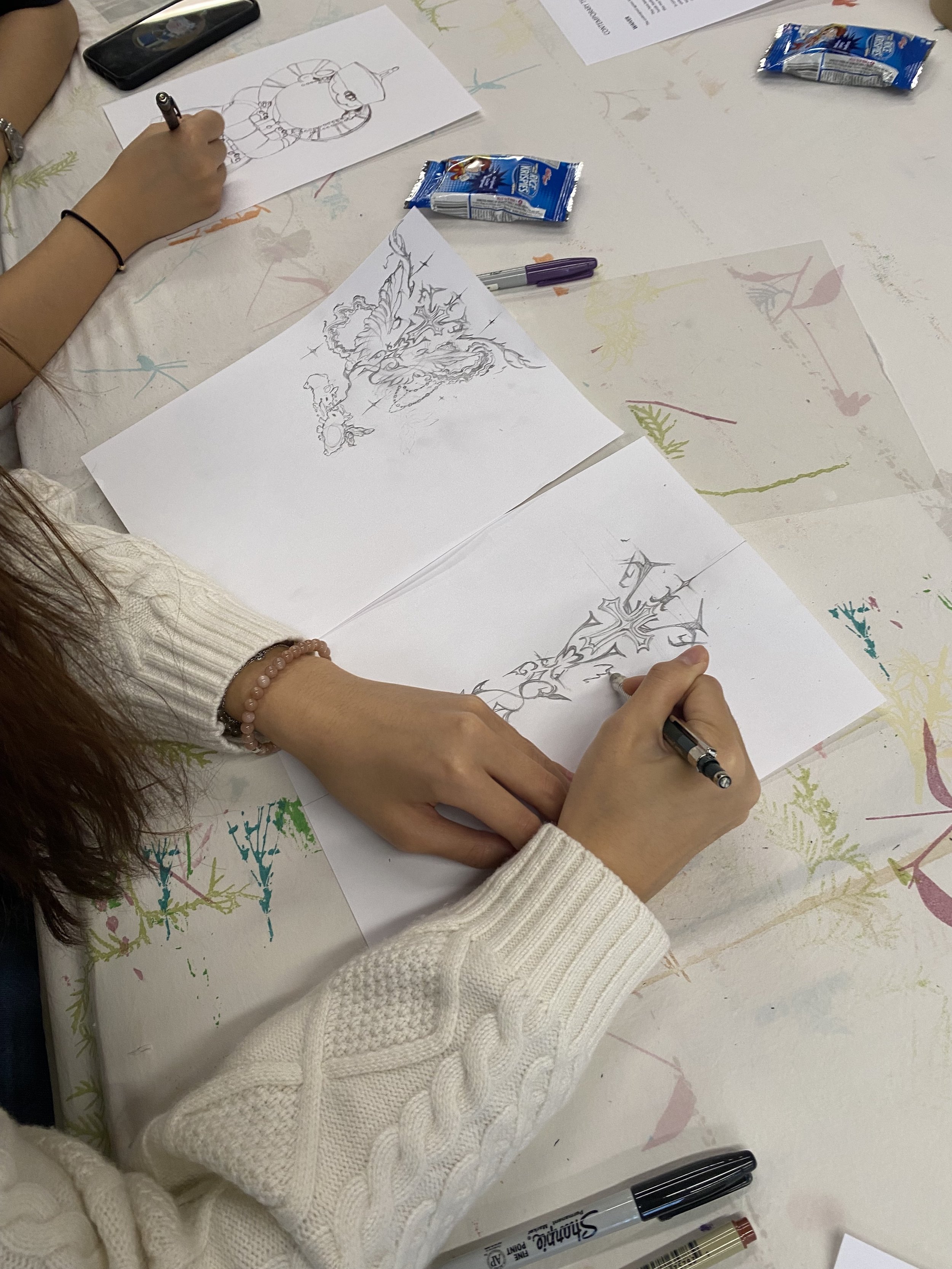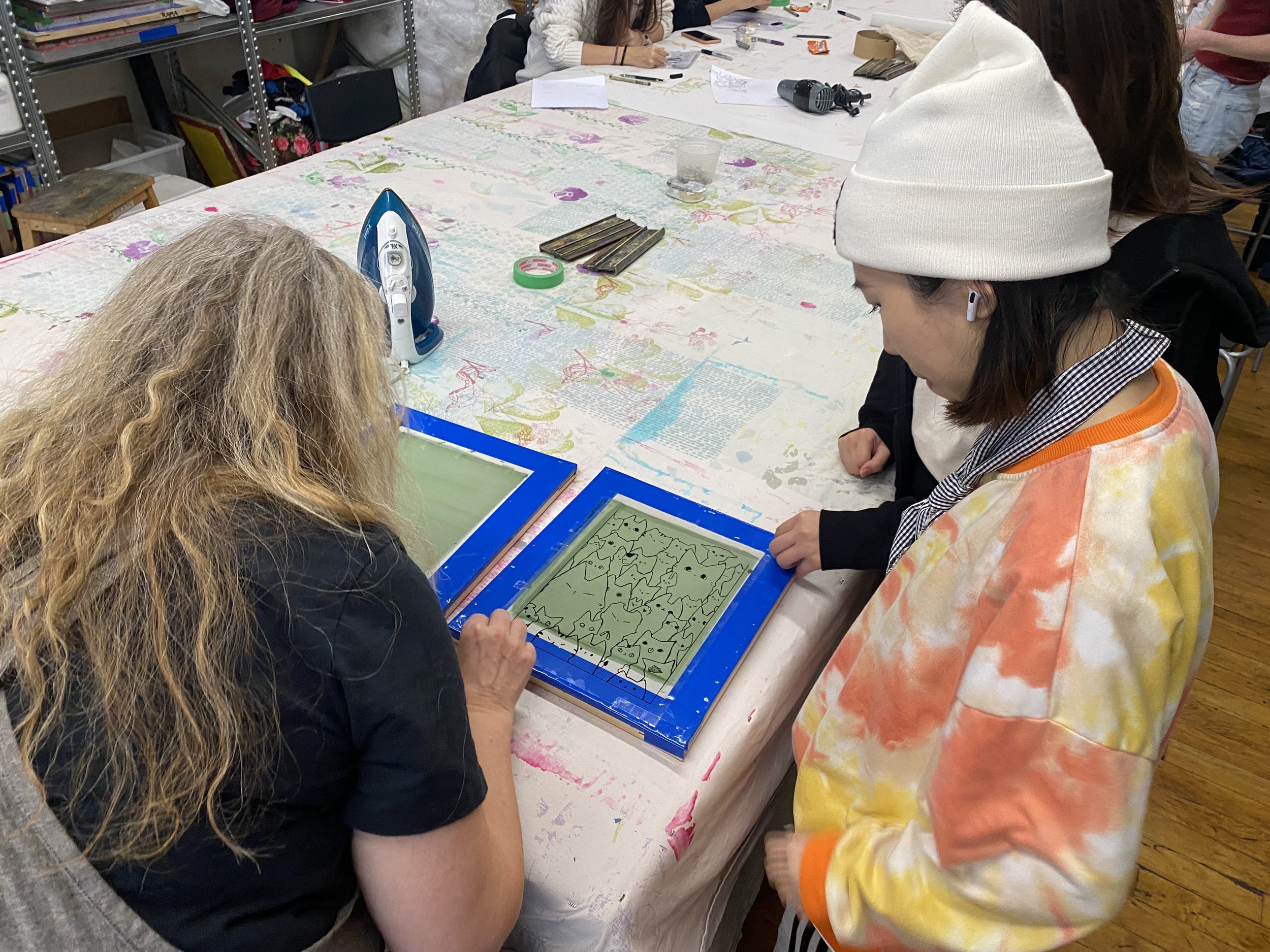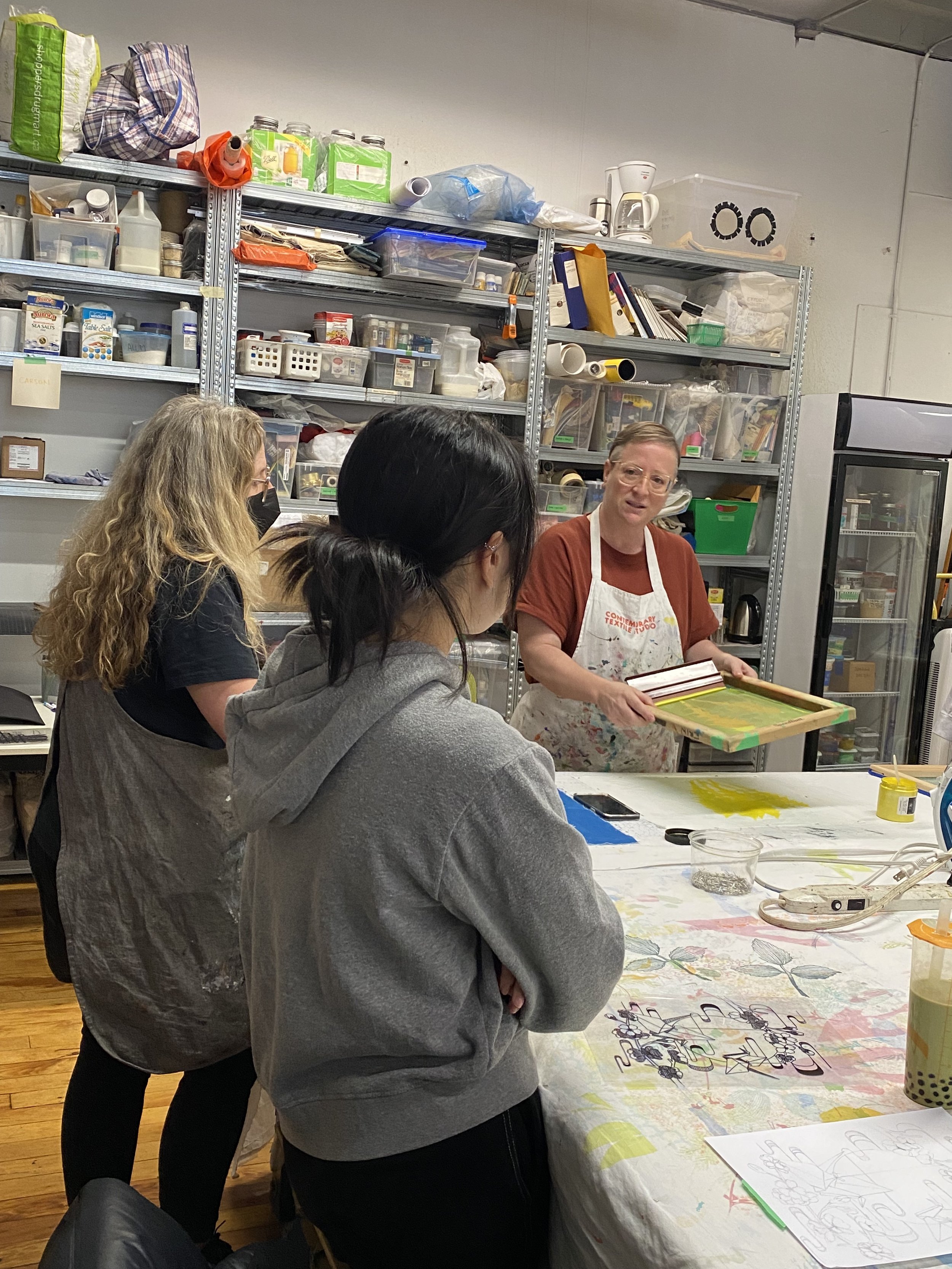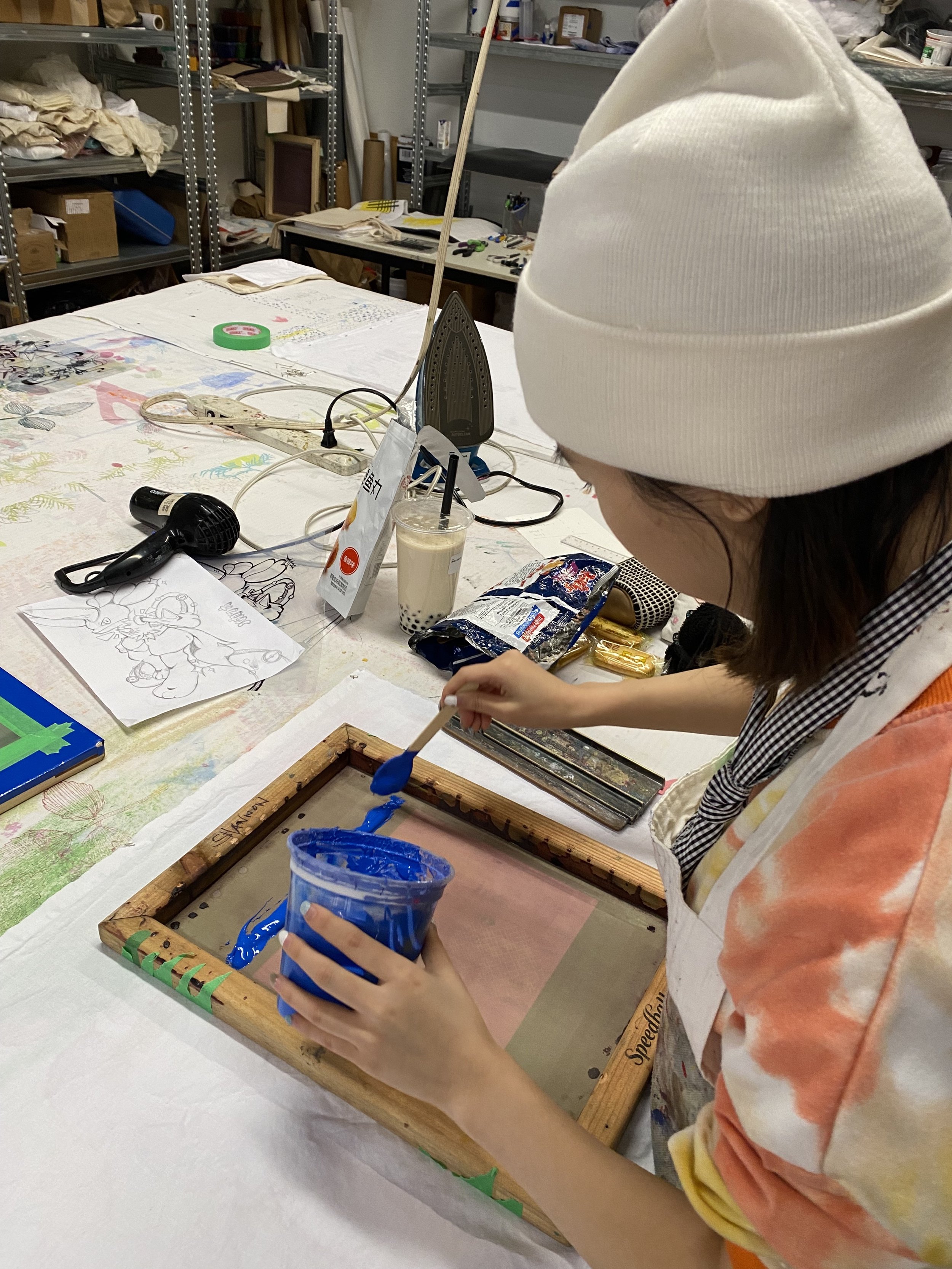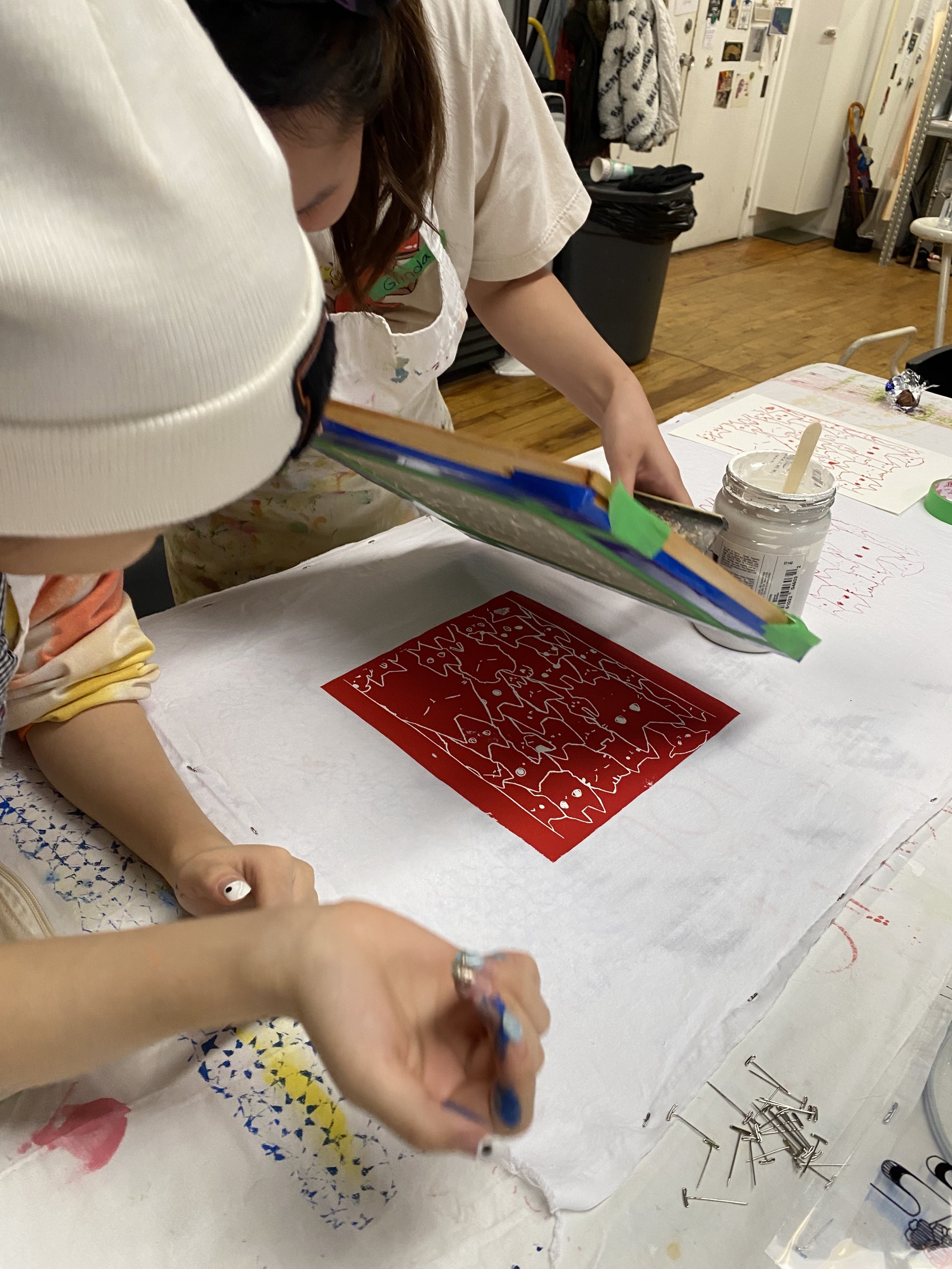Some Assembly Required 1.0 + 2.0: Current Practices from Members of the Contemporary Textile Studio
February 2025
DesignTO Festival
January 24 - February 12
Featuring work by: Munira Amin, Katherine Childs, Diana Fox-Revett, Gitte Hansen, BR Goldstein, Carolanne Graham, Rachel MacHenry, Erin MacKeen, Shannon Smith
This exhibition has two locations:
1.0 @ 99 Frames (527 Parliament Street)
2.0 @ Leaves of Trees (177 Queen Street East)
This duo of exhibitions showcases work from a cooperative of textile artists who share a studio space in downtown Toronto. These artists, from varying backgrounds, are unified by this creative space and a shared exploration of design and fibre arts that bridges art and craft, beauty and utility. They engage with processes that have a rich history and renewed contemporary application, such as natural dyeing, stitching and embroidery, slow fashion, repurposing materials, foraging, handwork, printing, and communal making. These human-centred practices also speak to sustainability, respect for resources, and making meaning from what we create and how we contribute to an inclusive collective experience. Everything included here required assembly by hand, and in some cases, many hands, and we wouldn’t want it any other way.
IMAGES
(top left to right) Erin MacKeen (1.0), Handwork Studio: Munira Amin + Rachel MacHenry (1.0), Carolanne Graham, Katherine Childs (1.0)
(gallery top L-R): Katherine Childs, BR Goldstein, Gitte Hansen (1.0); Diana Fox-Revett (1.0); Carolanne Graham (1.0);
(gallery middle L-R): Shannon Smith, Diana Fox-Revett (1.0); Gitte Hansen (1.0); Gitte Hansen, Katherine Childs, Diana Fox-Revett (2.0)
(gallery bottom L-R): Shannon Smith (2.0); Diana Fox-Revett (2.0); Gitte Hansen (2.0)
Leisa Rich Fibre Arts Residency Awards Recipients 2024/2025: Lizz Aston, Natalie Leung, and Mary McKenzie
Ganaele Langlois, December 2024
The Leisa Rich Fibre Arts Residency Award grants three recipients with fully-funded four-month residencies at the Contemporary Textile Studio Co-Op. This year’s recipients are: Lizz Aston, Natalie Leung and Mary McKenzie.
LIZZ ASTON is a textile artist, educator and designer. She has been commissioned public artworks for Google, Harvard Kennedy School, Holt Renfrew and Lululemon, and has worked on sponsored projects with H&M Canada, the City of Toronto, 3M and the Japanese Paper Place.
Her work contemporizes historic textiles while exploring ways of abstracting them visually and materially to create new meanings for the viewer. By playing with methods of abstraction and incorporating handmade processes with digital ones, she deconstructs familiar patterns and reimagines them as large-scale, three-dimensional, distorted and exploded views.
For the residency, she will be developing a new body of pattern-based textile work inspired by bold patterns, colour field painting and minimalist abstraction. She will be exploring surface design, mark-making, analog and digital image manipulation techniques along with dye & print, polychromatic screen printing, stitch & construction on paper and cloth.
Website: www.lizzaston.com
Instagram: @lizzaston
Linkedin: www.linkedin.com/in/lizzaston/
NATALIE LEUNG is a textile artist and designer with a background in fashion and costume. Her artistic work explores themes of mixing, blending influences, nostalgia, imperfection, and how her Chinese-Canadian cultural upbringing has shaped her perspective.
Through this residency, she will be exploring natural dyeing, screen printing, and hand-quilting techniques to incorporate into a small series of sculptural and quilted pieces.
Website: www.waiwahstudio.com
Instagram: @waiwahstudio
LinkedIn: linkedin.com/in/natalie-waiwah-leung
Toronto-based artist MARY MCKENZIE is a ceramic artist whose work is deeply influenced by the drape and flow of textiles. In 2019 Mary McKenzie's solo exhibition Metamorphosis in the Gardiner Museum foyer and shop contained integrated textile/ceramic pieces and was featured in Ceramic Art + Perception, 2023.
Her textile-making process begins with donated or found materials, which are used as-is or deconstructed for reuse as raw material and reworked by various means, including dyeing, tearing, stitching, drawing, collage, and so on.
For the residency, she will rethink her image-making process by bringing her experience of drawing and painting to her beginner’s eye in textiles. She will create a body of mixed-media, textile-focused work in 2D and 3D. Her goal is to learn stitching methods, screen printing, batik, and other textile techniques while repurposing materials redirected from landfills.
Instagram: @mckenzieceramics
Images: (people left to right) Lizz Aston, Natalie Leung, and Mary McKenzie. (top) work by Lizz Aston, (middle) work by Natalie Leung, (bottom) work by Mary McKenzie.
Interested in joining the studio? We also offer multiple options, from short-term and student residencies to full-time membership.
Leisa Rich Fibre Arts Residency Award Recipient: Timothy Manalo
Shannon Smith, October 2024
The Contemporary Textile Studio Cooperative is pleased to introduce the second recipient of the Leisa Rich Fibre Artist Residency Award 2023/2024 in collaboration with Craft Ontario. Timothy completed his residency earlier this year.
Timothy Manalo is a sculpture and installation artist born and raised in Toronto, Ontario, Canada. In 2010, he graduated with a Bachelor of Fine Arts from OCAD University, majoring in Sculpture and Installation. Following his undergraduate studies, he worked extensively in the fabrication industry as a studio assistant and in-house sculptor for various companies specializing in art and design fabrication that included, outdoor commercial sculptures, mascot costumes and props, interior wall finishing and custom art.
In 2019, he completed a Master of Fine Arts in Studio Art from the SMFA at Tufts University in Boston, with a Certificate in Museum Studies. Following his studies, he was awarded a Post-Graduate Teaching Fellowship, teaching 3D Foundations for a full academic year. Manalo has exhibited in galleries in Canada and the United States that include the Canadian Sculpture Centre in Toronto, the Museum of Fine Arts in Boston, Massachusetts, and was an artist-in-residence at Franconia Sculpture Park in Shafer, Minnesota. He is also a Researcher at The After School with the Center for Arts, Design and Social Research.
By the time you came to the studio you had already completed multiple degrees, artist residencies and had a variety of design experience. How has your residency with the Co-op changed or shaped your work going forward?
When I first started the CTS residency, I was really focused on continuing to develop my weaving practice, which I saw as an extension of my sculpture practice. What I found were artists with a wealth of knowledge in the area of natural dye who were very open to sharing their skills and encouraged me to experiment. By being here, it lit the spark of learning natural dye, which wasn’t necessarily my initial intention, but became essential to expanding my explorations in the language of materials and how they equate to a time and place. I became much more conscious of the language of material and how textile communicates. I also took Jason Logan’s Natural Ink Making workshop at the studio, which was another launching point. I have to say that having a routine really opened up possibilities. I came into the residency with the intention to build structure into my weaving practice which enabled me to learn new skills. I really looked at this Award a prize worth money and to use every penny to the last drop.
Which elements of natural dye did you learn most about and incorporate in your weaving practice?
Indigo is a fascinating cosmological process of geography, climate, weather, and bacteria that is also culturally significant and has archival qualities. Also simple things like annatto and onion skin. I also made a mud bath from clay foraged at a previous residency in Spain. I dyed mainly cotton and linen yarn, which was then incorporated into my weavings.
What have you been working on since completing your residency?
I attended the first of two residencies as part of The After School, a worldwide community of artists and researchers. We spent 10 days in Turkey where my previous exploration into the communication of materials through natural dye helped to inform that experience. The everyday events and rituals of waking up, eating together, talks at the house and engaging with that space, going to the spice market, eating the walnuts we purchased, then making the husks into a dye bath, also making dye from crushing bricks we found—these all connected to the time and place and the creating of a material archive.
Next, Timothy is off to Nairobi, Kenya to complete the 2nd of his two-part residency with The After School.
Leisa Rich Fibre Arts Residency Award Recipient: Diana Fox-Revett
Shannon Smith, March 2024
The Contemporary Textile Studio Cooperative is pleased to introduce our first of three recipients of the Leisa Rich Fibre Artist Residency Award 2023/2024 in collaboration with Craft Ontario.
We’re also thrilled to announce that Diana has joined us as a full-time member as of March 2024!
Q + A with Diana Fox-Revett, modern quilting artist and teacher.
You are CTSC’s first recipient of the Leisa Rich Fibre Artist Residency Award, what stands out for you so far?
I started at the studio in November. So far I have especially enjoyed the community of artists that work here: that has been my biggest joy of being in the space. Connecting with others and having impromptu conversations and talking about our work in a casual sympathetic way feeds my creativity and pushes me forward.
And have the studio facilities provided you with any new opportunities for experimentation?
I am enjoying the print table. I studied surface printing in school many years ago but really have done very little since. I am enjoying learning new skills from others, some ideas/techniques that I could possibly use in my college teaching. In addition to textile dyeing and stitch work, I have been a volunteer, helping with workshops.
Can you tell us a bit about what you have been working on in the studio?
My recent work involves slow hand stitched quilt works using up-cycled textiles that I have dyed with natural dyes to create a harmonious colour palette. Slowly piecing with no plan for the outcome. My work is laborious and time consuming. I don't want to put out a huge volume of work. I prefer to work slowly and carefully to make items that will last.
Mostly, I just love to play with colour. One small piece of fabric at a time.
You can see more of Diana’s work and process:
Members at
DesignTO 2024
Shannon Smith + Ganaele Langlois / January 2024
The DesignTO Festival is back from January 19 - 28 all over the city and features several textile craft, design and fashion installations, including some of our members.
Gitte Hansen has a solo exhibition - Forest Underwater inspired by the life-giving force of photosynthesis from plant life that inhabits both land and sea. Gitte’s current practice focuses on working with natural dyes from local plants and minerals from the earth that have been used for thousands of years to produce colour onto intricately designed hand-painted and silkscreened works.
Forest Underwater includes both work in the retail space, Leaves of Trees (177 Queen St. East), viewable during venue hours) and a window installation (viewable 24/7 from outdoors).
Over at 99 Frames (527 Parliament St.), the exhibition Embroidery as Contemporary Expression explores the diasporic experience and the challenges of maintaining and adapting one’s cultural heritage in the face of profound life changes. Members Rachel MacHenry, Munira Amin, Ganaele Langlois and former member Ana Galindo, as part of the Drawing into Threads Collective, are presenting a creative process where women embroiderers from Toronto’s Regent Park community were guided through a back-and-forth between drawing and embroidery to foster new forms of expression.
Thank you to the Ontario Arts Council for their support.
Spotlight: Oliva Mae Sinclair
Ganaele Langlois / February 2023
I first met Olivia Mae Sinclair at the 2022 Toronto Comics Arts Festival, where she exhibited her silkscreened cloth diaries, books and poems. Olivia work is unique and singular, using cloth to make books, leaving seams and threads visible to challenge and complexify the book format, developing a seemingly simple black and white esthetics to create complex layers of visuals and texts. We met in early 2023 to talk about the versatility of silk-screening as a creative medium.
Hi Olivia, where does this idea of cloth books come from?
I did my undergraduate degree at Sheridan College, and for a long time I felt like I didn’t have an artist identity. Then, two things happened: first, I read Milk and Honey by Rupi Kaur, which combines autobiographic poetry and drawings to address the many facets of pain. And then, I received an assignment in my Printing class to make anything I wanted. So I put two things together: the autobiography/memoir genre and cloth. I looked through all the printed pieces I had and developed some new one to create my first cloth book. And I realized that this is what I wanted to do forever.
When did you decide on silk-screening as your main form of expression?
Around the same time as I started creating cloth books, in undergrad. I can’t draw the way I want to, so I turned to photography transferred on cloth as a way to work with visuals. I also worked at a screenprinting facility for a year and loved the experience. Being able to see production from an industry standpoint really helped me streamline my own production process.
What’s your creative process? Do you imagine a finished book or does an idea take shape as you go?
I have two types of creative processes. The first type is for my sculptural and conceptual art. This is when I let myself be guided by my creative intuition and skills and get into a conversation with my materials. I use pieces that I have already made and combine them with new work, in a sloppy and unstructured kind of way. I like to focus on executing ideas as fast as possible, aiming to finish a project in one week.
My other process is for my book production line: here I am more thoughtful and methodical. I first define the title and content and then I spend time with the images and text. I spend a lot of time with manual collaging as well as working with a design software. I really pay attention to the formatting and to the appropriate way to cut and assemble pages. This takes a longer time than my sculptural and conceptual art.
Olivia will be teaching a Storytelling Through Screen Printing workshop on March 18 + 19, 2023.
Screen Printing Fundamentals
Shannon Smith / December 2022
We recently hosted an Screen Printing Fundamentals workshop for a group of grade 12 students from Holy Trinity School. Led by our Studio Coordinator Erin MacKeen and Member Shannon Smith, students engaged in a full day of preparing their own artwork, learning how to expose a screen, and the fundamentals of printing techniques.
For our morning session, we explored the many different methods of creating artwork for screen printing, from direct drawing on transparent mediums to cut-outs with black paper and creating hand-cut stencils with vinyl. Students got to see our studio darkroom where we showed them how to expose their artwork on a screen in our UV exposure unit. We took a lunch break where students went out to explore the many different restaurants and cafes around 401 Richmond (there was a lot of bubble tea consumed).
In the afternoon we dove into printing on fabric samples and paper, and students designed their own bandanas and large canvas pouches for holding art materials. Some students also brought their own tote bags and t-shirts to print their designs on. They explored layering and multi-colour techniques and produced some incredible work.

Safflower Dyeing
Ganaele Langlois / October 2022
Japanese Shifu (paper) weaver and natural dyer Hiroko Karuno spent a few days at the studio this October doing Benibana (Safflower, Carthamus tinctorius) dyeing. Depending on the nature of textile fibres and the number of dye layers, safflower ranges from oranges and light pink to hot pink and crimson.
The process to extract the red dye from safflower petals is exacting and takes place over three days. First, petals are kneaded under water for several hours to extract a first yellow dye. Our focus, however, was on extracting the second, red dye. To do so, petals are covered with lye water and further kneaded for several hours to extract their red dye. The PH of red liquid is then neutralized with the addition of rice vinegar, and the dye bath is ready. Safflower red dye is self-mordanting, and follows the same logic as indigo as repeat dipping of fifteen minutes lead to deeper and brighter colours. We obtained a range of pinks on cotton and hemp, and coral on silk.
Hiroko Karuno shared her collection of safflower-dyed samples, including a deep crimson obi that took fifteen dips to achieve.
The next steps will include extracting red pigment to paint on paper.
Let us know if you are interested in a workshop on safflower dyeing!
Image above: final results of safflower dyeing on hemp, cotton, silk, cotton khadi, and light cotton voile.

Hiroko’s collection of safflower-dyed textiles and papers



Process: extracting the yellow dye (1 and 2)


and red dye (3 and 4)

Exhausted petals and final extraction of the red dye

Preparation of the dye bath with the addition of rice wine vinegar


and dyeing









